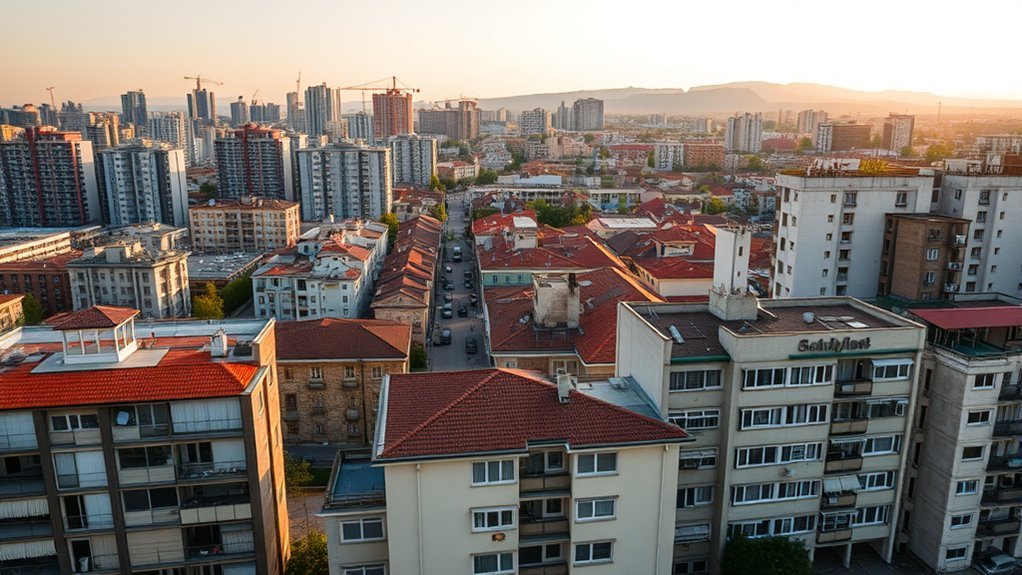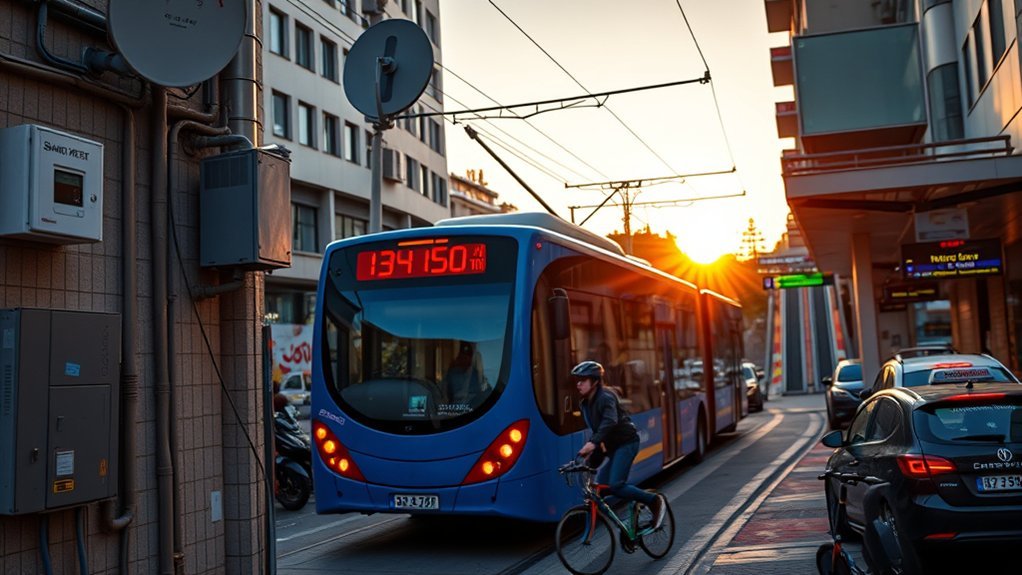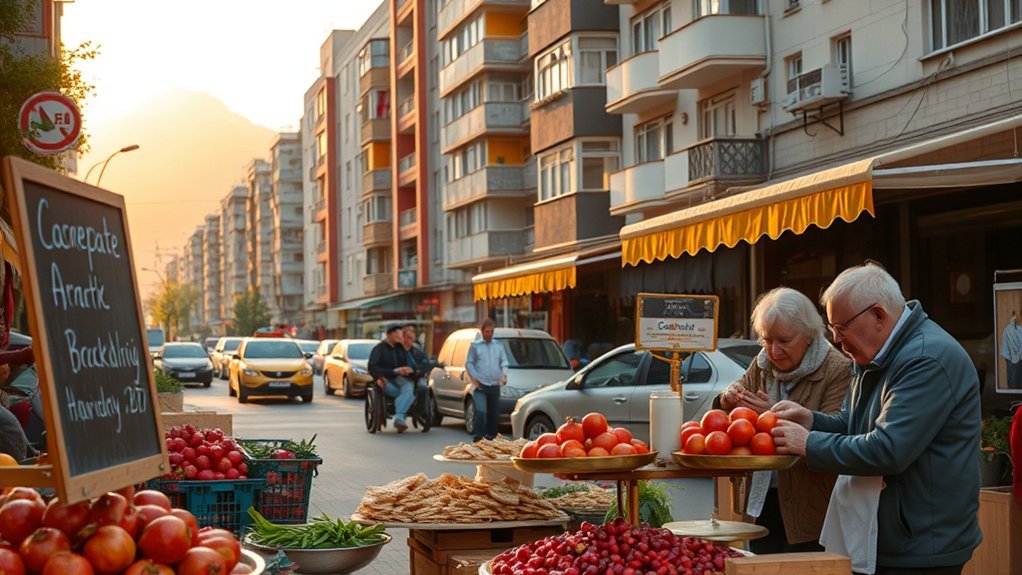Living in Armenia is generally affordable compared with many capitals: you’ll find groceries, public transit and utilities cheap, but rent takes the biggest bite. In Yerevan a one‑bed in the centre averages ~340,500 AMD/month, outside ~229,000 AMD; combined utilities and internet add ~60,000 AMD. Average net pay is about 232,250 AMD, so you’ll often need to prioritize housing and transport. Keep short‑term rentals near transit to save — more specifics follow if you want.
Cost of Living Overview and Key Numbers

Although living costs in Armenia are well below many world cities, you’ll still see higher prices in the capital: the national Cost of Living Index is about 41 (April 2025), while Yerevan sits at 44.3 with a Rent Index of 19.6—meaning everyday goods are moderately priced but rents remain relatively low compared with other capitals.
Armenia is affordable overall, though Yerevan costs more—everyday items stay reasonable while rent remains relatively low.
You’ll find that average monthly net salary after tax (~232,250 AMD / $592) covers roughly half a month’s typical living expenses by national averages, so budgeting matters.
Food prices are low: inexpensive restaurant meals ~4,500 AMD, a McMeal ~3,500 AMD, milk (1 gallon) ~2,403 AMD, eggs (12) ~937 AMD.
If you’re comparing options, an Apartment in City centre (1‑bed) runs about 340,500 AMD/month; utilities for a ~915 sq ft place add roughly 51,349 AMD/month.
Use these figures to weigh daily spending against income and compare Armenia’s Cost of Living to other capitals when planning a move or extended stay.
Housing and Rental Prices by City

Expect higher rents in Yerevan than elsewhere in Armenia: a one‑bed in the city centre averages about 340,500 AMD/month (range ~232k–500k), while outside the centre you’ll pay roughly 229,000 AMD (150k–320k), and a three‑bed in central Yerevan runs about 576,000 AMD (380k–1,000k).
You’ll notice the national Cost of Living reflects this split: Yerevan’s COL Index sits around 44.3 while the Rent Index is low-ish at 19.6 compared with many capitals, but rents still outpace typical earnings.
If you rent, compare city versus suburban options — one‑beds outside the centre are markedly cheaper.
If you buy, Apartment Prices in city centres average about 125,230 AMD/m2 (≈ $3,157/m2) versus lower suburban house prices (~$1,483/m2).
Given the monthly net salary near 232,250 AMD, you’ll often spend a large share of income on city rent, so balance commute, space and cost when choosing where to live.
Food, Groceries and Eating Out Costs

When you budget for food in Armenia, expect inexpensive restaurant meals around 4,500 AMD (with a 2,500–9,750 AMD range) and McDonald’s McMeals near 3,500 AMD.
Basic groceries are also affordable—milk about 2,403 AMD per gallon, a dozen eggs ~937 AMD, and chicken breast ~7,490 AMD per kg—while a mid-range bottle of wine runs near 4,000 AMD.
Typical Meal Prices
If you’re eating out in Armenia, meals are generally affordable: a simple dish at an inexpensive restaurant runs about 4,500 AMD (typically 2,500–9,750 AMD). You’ll find costs lower than many Western cities, though Living decisions can shift if you’re comparing to a higher cost of living elsewhere. A McMeal averages ~3,500 AMD, and a mid-range wine bottle is ~4,000 AMD. A dinner for two at a mid-range place averages roughly $49.30.
| Item | Typical Price (AMD) | Notes |
|---|---|---|
| Inexpensive meal | 4,500 (2,500–9,750) | Ticket (Local) range |
| McMeal | ~3,500 (2,500–4,200) | Fast food |
| Bottle of wine | ~4,000 | Mid-range |
You can eat out frequently without large expense.
Grocery Staples Costs
Alongside affordable restaurant meals, shopping for groceries in Armenia is generally budget-friendly and often cheaper than in Western Europe. You’ll find staples like milk (≈2,403 AMD/gallon), a dozen eggs (≈937 AMD), and rice (≈2.25 USD/kg) cost less than in many Western cities.
Apples (~1.27 USD/kg) and potatoes (~0.77 USD/kg) keep your produce bill low, and a mid-range bottle of wine runs about 4,000 AMD. If you compare a McMeal (~3,500 AMD) or cappuccinos (~3–3.50 USD) to dining out, cooking at home saves money.
Note local factors—seasonal supply, Ticket (Local) market access, and macro influences such as an Interest Rate shift—can nudge prices up or down.
Transportation, Utilities and Internet

You’ll find transportation, utilities and internet in Armenia are generally affordable compared with many capitals: a single local bus or minibus ride costs about 100 AMD while a monthly pass runs roughly 4,000 AMD.
Public transit, utilities and internet in Armenia stay affordable — single bus rides about 100 AMD, monthly passes ~4,000 AMD.
You’ll pay low fuel prices too—around 2,044 AMD per gallon—so driving is cheaper than in many countries. Public transit coverage is good in Yerevan, and monthly pass ranges (3,000–7,000 AMD) keep commuting predictable.
For a typical 85 m2 apartment, expect combined utilities (electricity, heating, cooling, water, garbage) near 51,349 AMD per month, with seasonal and usage variability between about 34,000 and 75,556 AMD.
Internet is competitively priced: unlimited 60 Mbps+ plans average about 8,547 AMD monthly (6,000–12,500 AMD).
Rent and cost-of-living indices reflect low rental pressure and moderate overall costs, so utilities, internet and transport remain modest contributors to monthly expenses compared with many Western capitals.
Salaries, Affordability and Monthly Budgets

Because wages in Armenia sit well below many Western averages, you’ll quickly see why budgeting matters: the average monthly net salary is about 232,250 AMD (≈ $592), which only covers roughly half of typical living expenses in Yerevan.
That gap forces choices: rent is the biggest drain—expect ~340,500 AMD for a 1‑bed in the centre or ~228,900 AMD outside it.
Add utilities (~51,349 AMD) and internet (~8,547 AMD) and you’re already past a single salary in many cases.
The country’s Cost of Living Index (≈41; Yerevan 44.3) shows Armenia is cheaper overall, but urban costs concentrate in housing and childcare.
Regular costs—meals (~4,500 AMD), transport pass (~4,000 AMD)—are low, yet private preschool (~141,000 AMD/month) or international school fees (~4,687,801 AMD/year) can eclipse wages.
If you live and work here, plan monthly budgets around rent-first, then utilities and childcare; compare centre vs. outskirts to stretch that modest income.
Tips for Budget Travel and Short-Term Rentals

You can save a lot by choosing rentals outside central Yerevan or in smaller cities like Gyumri or Vanadzor, where studios and small houses often run €15–€40 a night versus €25–€70 in the capital.
Book on local platforms, ask for weekly or long-week discounts, and confirm utilities and internet are included to avoid surprise costs.
For transport, use monthly/periodic passes (~4,000 AMD) and cheap intercity buses or low-cost taxis to keep daily expenses near €10–€20.
Finding Cheap Rentals
When hunting for cheap short-term rentals in Armenia, focus on suburbs and regional cities—Yerevan’s outskirts, Gyumri, and Vanadzor regularly offer nightly rates under €20–€30 compared with Yerevan centre’s higher rents.
You should target listings priced similarly to local long-term rents (Yerevan centre ~340,500 AMD/month vs outskirts ~228,900 AMD/month) and negotiate short-term discounts.
Use local platforms and Numbeo/Expatistan for price checks, prefer locally managed flats over international chains, and book off-peak.
Check if utilities (~51,350 AMD/month) and internet (~8,547 AMD) are included; these fees are often rollable into the nightly rate.
Always confirm cleaning and service fees before booking, since they can push a budget stay above your €20–€30 target.
Saving on Transport
After locking in a cheap rental, cut daily expenses by leaning on Yerevan’s very inexpensive public transport and selective taxi use. Buy single 100 AMD tickets for occasional trips; grab a 15–30 day pass (≈4,000 AMD) if you’ll commute daily — it’s far cheaper than repeated taxis.
For short hops use ride-share or taxis (8 km ≈1,500–2,000 AMD), but check apps and agree on airport fares to avoid surprises. For intercity travel choose marshrutkas and regional trains: they’re a fraction of private transfers and make day trips to Gyumri or Vanadzor affordable.
When renting short-term, prioritize locations near metro or main bus routes.
In summer, consider scooter or shared bikes; driving costs include gas (~2,044 AMD/gal).
Frequently Asked Questions
How Much Money Do I Need to Live in Armenia?
You’ll need about $500–$900 monthly in Armenia: rentcheaper in Yerevan, utilities ~₹51k AMD, food and transport low, so with modest lifestyle you’ll be comfortable on ~$600, while $900 affords more dining and extras.
Can an American Live in Armenia?
Yes — you can live in Armenia. For example, a US remote worker moved to Yerevan, entered visa‑free, rented affordably, taught part‑time, and used reliable internet. You’ll find low costs, expat communities, and clear residency paths.
What Is the Average Income in Armenia in USD?
The average monthly net income in Armenia is about $592. You’ll find annual GDP per capita near $8,501, but typical salaries often cover only half of living costs, varying higher in Yerevan and lower elsewhere.
Is Armenia a Cheap Place to Live?
Yes — you’ll find Armenia generally cheap, especially versus Western Europe or the US, though wages are low; expect affordable food, rent and services in Yerevan, but limited local purchasing power can curb lifestyle choices.
Conclusion
So you’ll find Armenia cheaper than Western Europe or the U.S., but don’t expect bargain paradise: Yerevan’s cafes and rents climb, while smaller towns stay reasonable. You’ll trade sky-high salaries for low living costs, pay less for groceries and transport, and stretch savings if you avoid pricey expat habits. If frugal, you’ll live comfortably; if not, you’ll still pay less — which is to say, affordability depends on whether you learn to live like a local.


